
Over 70 years later, Sporting News historian Paul MacFarlane discovered that Ty Cobb was mistakenly credited with two more hits than he should have, which would have made Lajoie the clear winner.
Napoleon Lajoie was loved by many, and seen as a hero. For a time, he was Cleveland's manager while he played and the team actually renamed themselves to the Naps, because he was loved so much by Cleveland. During the time that the team was named the Naps, the great Cy Young and Shoeless Joe Jackson played under him. Napoleon Lajoie was truly a remarkable player who may have been much better, had he not divided his attention to managing the team. He was quoted as saying being a manager was the biggest mistake of his career, as he felt it negatively affected his play.
With as incredible as Lajoie was, it is hard for your light to shine brightly when Ty Cobb is playing. From 1907 to 1919, Cobb won 12 batting titles. As he was such a force in baseball history, I made him my focus of a couple other baseball card examples that I wanted.
First, the T202 Hassan Triple folder.
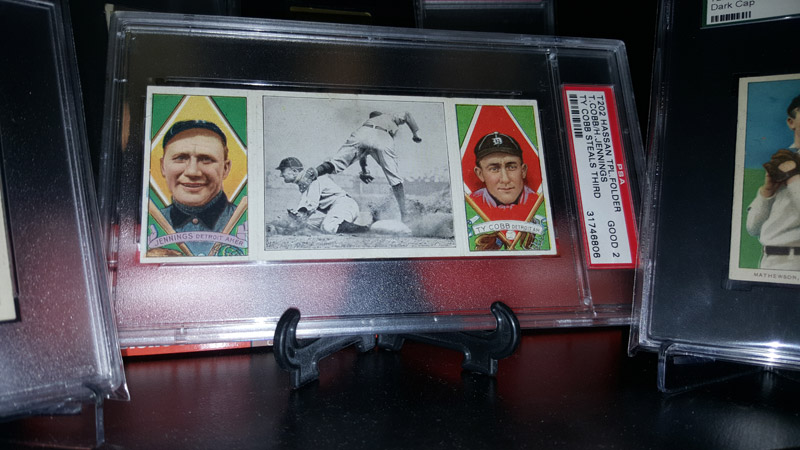
This card features an innovative design that allowed for both ends of it to be folded in, so that way it could fit in its box. This particular card features hall of famers on both sides, with one being Ty Cobb, of course. Perhaps the best thing about the entire card, is the action shot shown in the middle. If this picture looks familiar, it is probably because it is considered by many to be the most famous action shot in all of baseball history. In fact, a type 1 photograph of it recently fetched
$250,000 at auction.
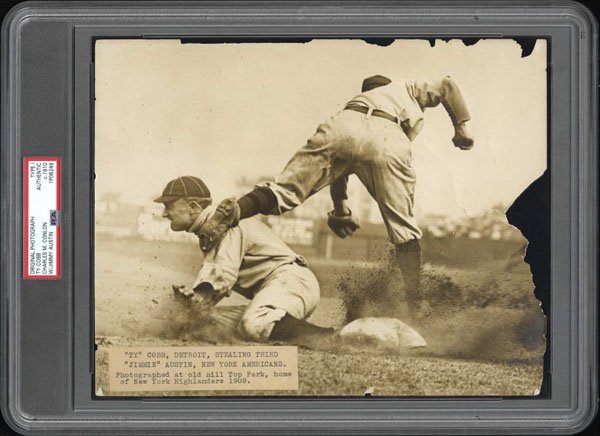
The photo was taken by renowned photographer Charles Conlon. What's amazing is that Conlon didn't even know he took the picture. He was speaking with Austin, the third baseman when Ty Cobb came in hard with his teeth clenched and spikes flying. Conlon, being friends with Austin, was worried that he may have been injured. On his trip back, Conlon said he wished he had taken the photo, and just in case, he changed plates. When he developed them, he was delighted to find that he did instinctively take the photo, which became perhaps the most popular photograph in baseball history - and he didn't even know it. The T202 Hassan Triple Folder that features the photograph is the only card that I know that features it.
My final Ty Cobb card to show is my favorite. It is a T3 Turkey Red, which is a cabinet card. Collectors could send in coupons from cigarette boxes and obtain these. They are significantly larger than regular cards, and are absolutely beautiful works of art. You can keep the Mona Lisa - I'm taking the T3 Turkey Red Cobb! Pictured below is my Cobb Turkey Red along with my Cracker Jack cards of Napoleon Lajoie, and hall of famer Tris Speaker. (I LOVE Cracker Jack cards!) Like Lajoie, Tris Speaker is a player whom I would consider to be vastly underrated by today's casual fan and is definitely worthy of the baseball royalty title.
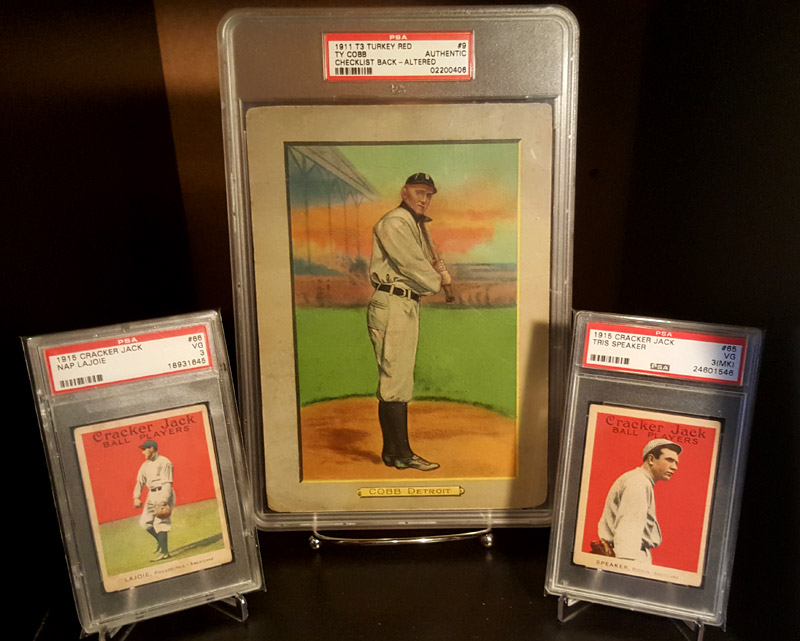
If you are keeping score at home, there is one notable superstar of the early 20th century that is missing. Can you guess who? I'll give you a hint: He was considered by many to be the best in the game. His name starts with an "H" and ends with "onus Wagner". The man who's T206 card has sold for millions of dollars. Sadly, I don't have millions of dollars to throw aro....well actually, I just don't have millions of dollars. What I do have however, are a couple cards that excite me to no end.
Tobacco companies weren't the only ones creating cards during this time period (as shown by the 1915 Cracker Jack cards above.) Candy makers, Newspapers, and others were as well. I'm thankful they did, because without them, I would not have been able to add the next two cards.
It is generally accepted that the E102 set predates the T206 Wagner, which is cool in and of itself. Its stark red background with Wagner at bat is simply striking. As with most of my cards, this one in particular looks much better than the numerical grade it was assigned. As a bonus, being from 1909, it hold extra significance as Honus Wagner and Ty Cobb went head to head in the World Series. As the legend goes, when Cobb first reached base, he yelled over to Wagner, calling him "Krauthead" and that he was coming to steal second. As Cobb attempted it, not only was he thrown out, Wagner tagged him so hard on his face, it busted his lip. That seemed to set the tone for the rest of the series, with Wagner demolishing Cobb in nearly every statistical category.

Does the name Carl Horner ring a bell to you? If not, let me tell you about him. He was a photographer that took portait pictures of many baseball players, that have been used on various baseball cards newspaper articles and more. His work has been featured in the T206 set, Cracker Jack and many others. He is most famous of course, for taking this photograph of Honus Wagner, somewhere between 1902 and 1905.
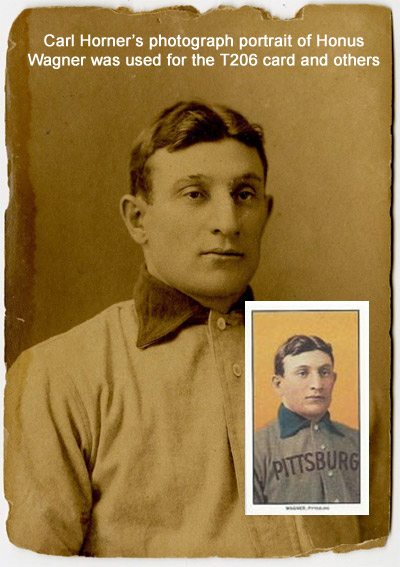
What many do not know is that this iconic photograph wasn't used just for Wagner's T206 card. It was used for a few others as well, including the 1910-11 Sporting Life M116 card. I have been extremely fortunate to have landed one, shown below! It is hauntingly beautiful, with its multi-colored background and Wagner's rosy cheeks. Owning an authentic Honus Wagner of the same age and same portrait as the T206 is a dream come true!
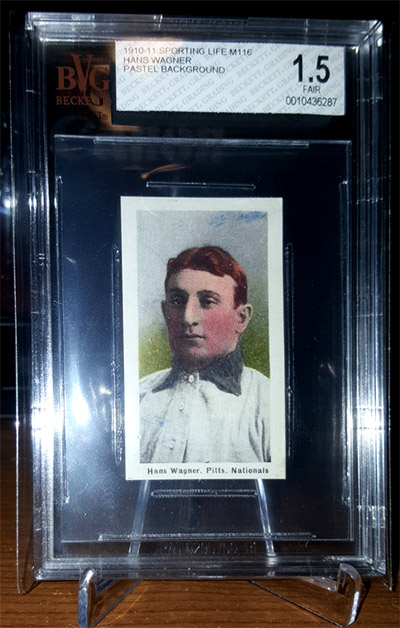 Not again! Where'd the beautiful baseball cards go?
Not again! Where'd the beautiful baseball cards go?
When World War 1 came into focus, and with it, America's involvement, Tobacco cards ceased to exist again. Candy and gum cards were still produced, yet were severely lacking from an aesthetic perspective. Throughout the last 1910s and 1920s, the majority of baseball card offerings were either black & white or what appeared to be primitive looking drawings with simplistic coloring. It wouldn't be until the 1930s that baseball fans were treated to a major release of baseball cards that could rival the beauty of those created decades prior.
With full color cards coming back into full swing, the superstars of the era were extremely popular.
Nicknamed "The Rajah", Rogers Hornsby is regarded as one of the best hitters in baseball history, having a career batting average second only to Ty Cobb. He has two triple crowns under his belt and is the only player to hit 40 home runs and hit .400 in the same season. Hornsby was a difficult man to get along with, and his teammates didn't like him much, but he was considered a dominant player in his era.

Did you know that Germany made sports cards? In 1932, Sanella Margarine created a sports card set on thin, large stock, with one of the subjects being baseball's #1 household name, Babe Ruth. If you were to ask anyone on the street the name of a baseball player, they will undoubtedly speak the name of Babe Ruth, while becoming tongue-tied while attempting to name another player. It is amazing that even back then, he not only transcended the game of baseball, but also America. The back of this card features all German text, and the front is extremely beautiful. It is great being able to own a piece of baseball history from Germany during an incredibly tumultuous time for their country. Nicknamed "Hitler's Butter Card" (okay, no it isn't), if you want a beautiful Babe Ruth card produced during his playing days that pre-dates his Goudey, this is an extremely affordable option. These can often be picked up for a couple hundred dollars or less.
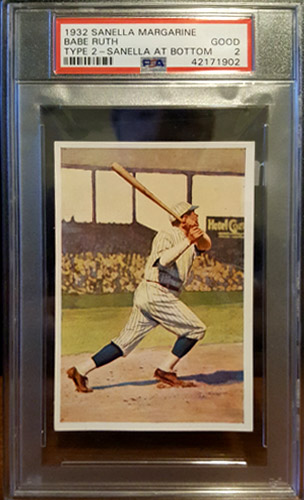
We all know about Babe Ruth, but how about the right handed Babe Ruth? Jimmie Foxx was nicknamed "The Beast" or "Double X". He was an incredibly strong man and would have tied Babe Ruth's then single season home run record of 60, except two home runs he hit were in rained out games. Lefty Gomez once said "He has muscles in his hair". Like Ruth, Foxx was also a dominant pitcher, if only for a small amount of time, compiling a 1-0 record with a 1.59 ERA in 9 games. Ruth had significantly more time as a pitcher at the beginning of his career, but Foxx pitched at the end of his. This 1933 DeLong issue is among his most popular cards ever.
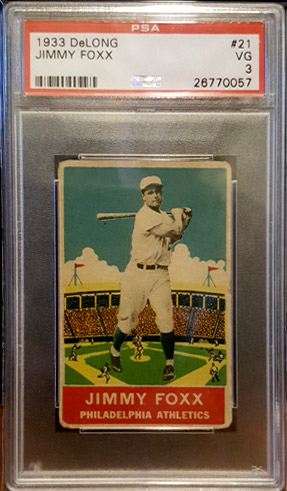
To wrap up the cards in the 1930s, I went with a few big-time cards of Yankee legends. From left to right, you have arguably the most famous and recognizable cards from Lou Gehrig, Babe Ruth and Joe DiMaggio. If you have seen baseball cards from any of these guys, the odds are that these cards are the ones that pop in your head first. They have dawned the covers of more magazines and price guides over the past several decades than can be counted.
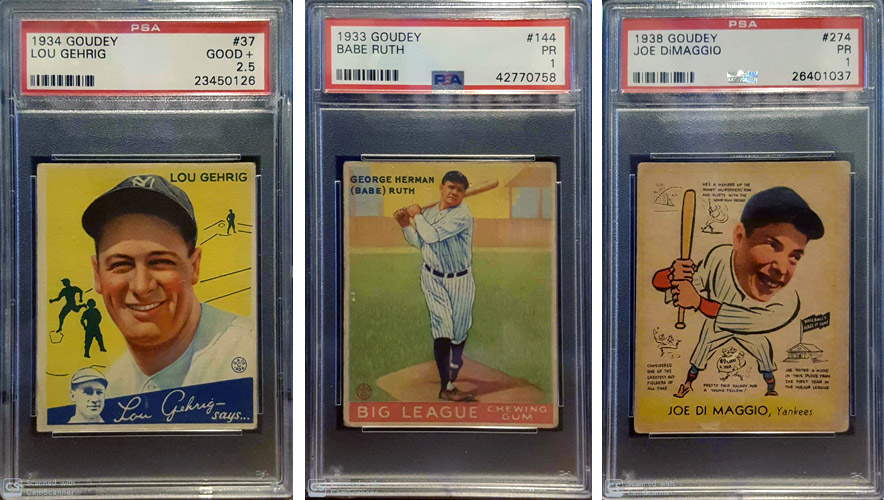
The next and final time period I'll cover with my pickups will be the 1940s and 50s. With both world wars behind us and the country booming, this is really when baseball cards started to ramp up. This time period also ushered in one of the richest eras of baseball heroes, ever.
The 1953 Topps portaits of Jackie Robinson and Satchel Paige are among my favorite cards in one of the most beautiful sets Topps has ever produced. I LOVE the Brooklyn bridge behind Jackie.
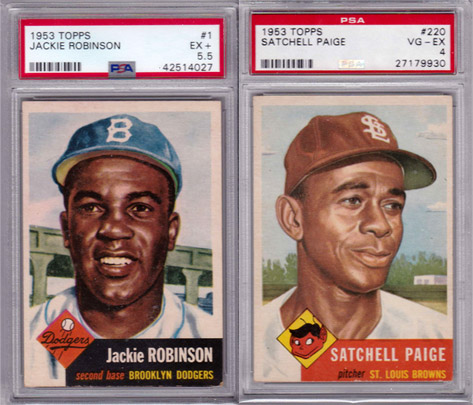
Going beyond that, I decided to go big and pick up rookies of Jackie Robinson, Satchel Paige, Hank Aaron, Roberto Clemente and Willie Mays.
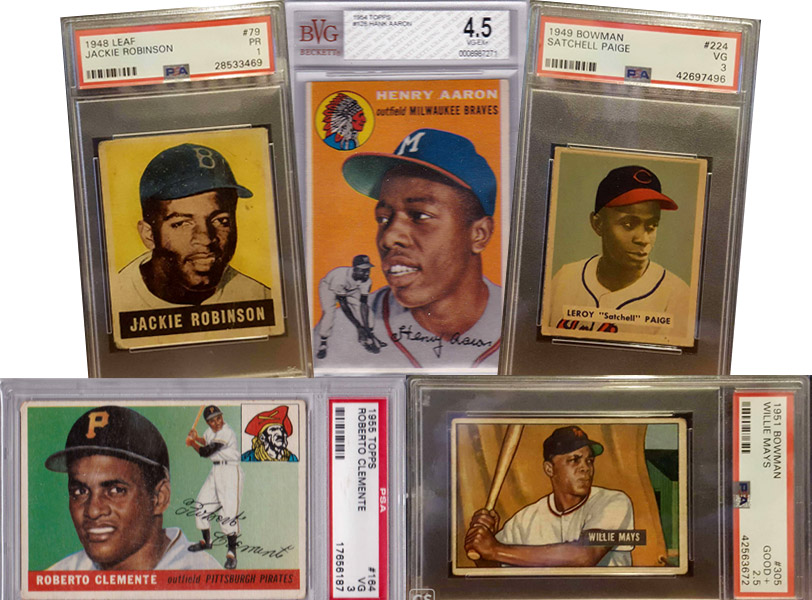
But wait, there's more! As a child, I was ecstatic if I would ever run across beat up commons from the 1952 Topps set. It would give me chills just knowing that they were in the same set as the famed Mickey Mantle card. I even wrote about it in my book ... see?

By now, many people have read about how Topps had an unreal amount of unopened cases of the last series of 1952 Topps in their warehouse for a decade, and couldn't give the stuff away. Eventually, they made the decision to dump them in the Atlantic, making them much tougher to find than the others.
The last card I have to show is the reason the story above is such a big deal. It isn't perfect, but it is the most popular baseball card in post-war history. Here it is, my Mickey Mantle:

Never in my wildest dreams did I ever think I would own this card, or frankly any of the others, for that matter! It all started with letting go of supercollecting. This adventure was wildly different. There was no stress, and no compulsive worrying about missing out on anything. Emotionally charged interests in any cards were tempered with level-headed, rational decision making when it came to purchasing. That is an extremely difficult thing to do as a supercollector when you go after 1/1s!
My mindset was mainly geared toward not just collecting, but investing - and telling a story through my new collection. It is my hope that it has done just that for everyone reading. None of these cards are going to the grave with me. In fact, they may gone tomorrow, in part or in totality. This journey was about obtaining and owning them, but make no mistake, while I am passionate about them and the story they tell, they are investments. In spite of whatever negativity is going on about graded cards today, I am a strong believer that vintage cards of key hall of famers are a safe investment, particularly those in a low grade with exceptional eye appeal. I am always open to buying, selling, trading or upgrading.
I have also picked up a few modern cards as well. These aren't all of them, but they are some of my favorites.
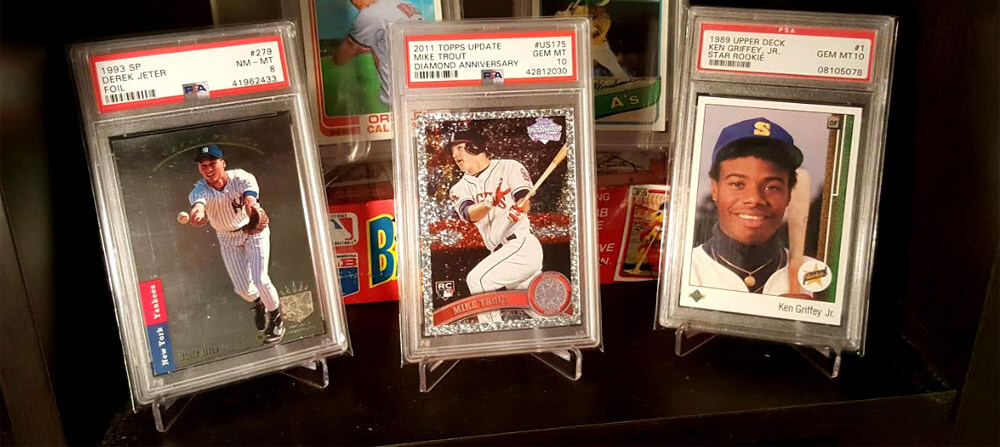 What about Canseco?
What about Canseco?
Last, but not least, I still do have some Canseco cards and continue to pick up some from time to time that catch my eye - especially if they are extremely rare and special. I still might get more excited about landing a special Canseco card than I do with anything else! It is just no longer my goal to get anything and everything. This year has been a fantastic learning experience for me, and has further confirmed for me that you don't need to buy every single card you don't have in any niche for enjoyment.
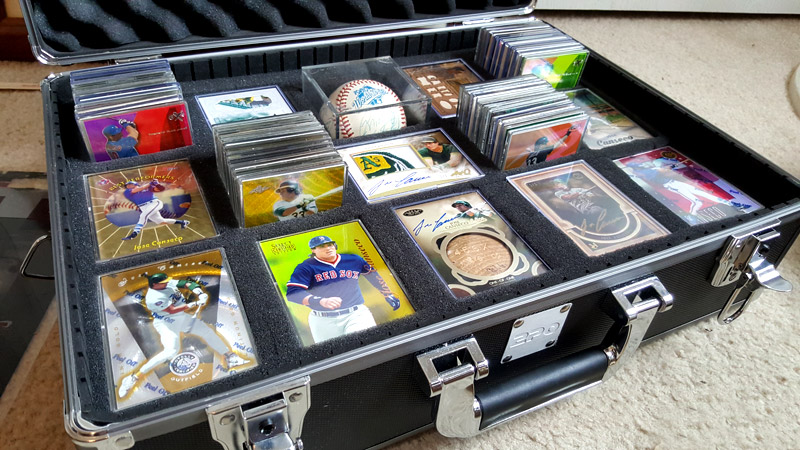
Before these cards go back to the bank, I wanted to take a few final shots of everything together:
(continued in the next post ...)